All About Power Wheelchairs
What is a power wheelchair?
Power wheelchairs, also known as electric wheelchairs or power chairs, are designed for people who lack the motor function or cardiovascular strength to operate a manual wheelchair. This includes people with mobility issues and seniors living in retirement homes, assisted living, or at home.
Most power chairs can be used indoors or outdoors and are battery-powered. Some power wheelchairs fold or disassemble into a few parts for transportation.
What are the main types of power wheelchairs?
There are three main types of power wheelchairs: travel/portable, full-size, and heavy-duty.
Travel power wheelchairs, also known as portable power wheelchairs or foldable power wheelchairs, can fold or be easily disassembled to fit in a trunk of a car or in airplane cargo.
Full-size power wheelchairs have larger seats, armrests, and footrests for more comfort. They usually travel farther per charge than travel power wheelchairs because they have a larger battery.
Heavy-duty (HD) power wheelchairs (also known as bariatric power wheelchairs) are for those that require a greater weight capacity than the standard 300 lb. These chairs normally have reinforced frames, heavy duty motors, and larger seats.
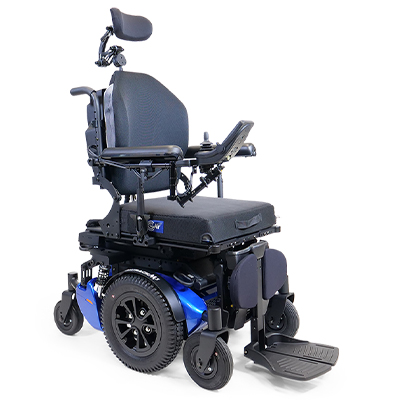
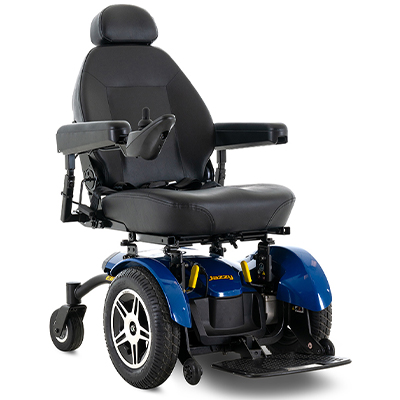
How do power wheelchairs work?
Most power wheelchairs come in two parts: the power base and the seat. The power base holds the batteries, motor, and other electrical components. The seat consists of the backrest, cushion, and armrests. The controller (meaning a joystick and keypad, in most cases) attaches to the armrest and is connected to the power base.
What features do power wheelchairs have?
Power wheelchairs are typically customized and prescribed by an occupational therapist (OT). In Ontario, they are purchased through the Assistive Devices Program (ADP) and must be determined by an ADP authorizer. The features you require will be customized fully by the provider for clinical positioning. Some features of power chairs are considered upgrades that are not covered by the Assistive Devices Program. Call Silver Cross to connect with an ADP authorizer near you.
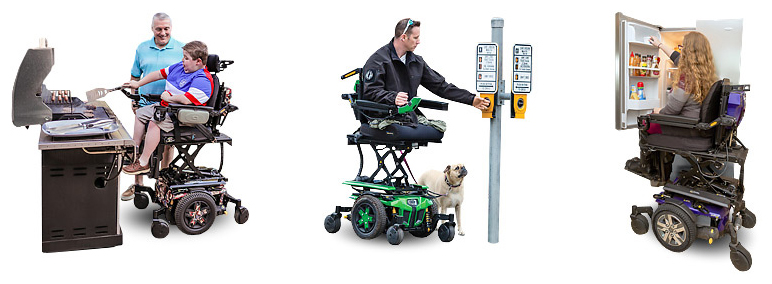
Wheels
Typically, power wheelchairs come with two larger wheels (called “drive wheels”) that are connected to the motor and 2-4 casters which help with stability. The drive wheels may be located in the front, middle, or rear of the chair. Larger and wider wheels and casters will travel better over rough terrain, making the ride smoother.
There are two main types of wheels available for power wheelchairs: pneumatic and foam-filled wheels. Pneumatic wheels are filled with air (like a car tire) and tend to promote gentler riding because they absorb shock. They also offer more traction and stability. Pneumatic wheels will need to be inflated when they start going flat since they can puncture.
Foam filled wheels (or “flat-free”) are puncture-proof, and as the name suggests, filled with foam. The wheels are low maintenance, but the ride is not as smooth as pneumatic wheels.
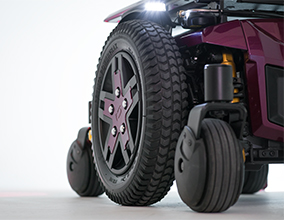
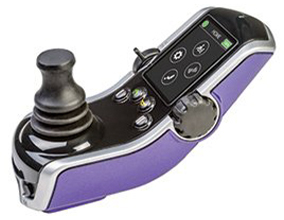
Casters
Casters help stabilize the power wheelchair while it is in motion. More compact casters can help make tighter turns indoors. Casters are usually located opposite the drive wheel. For instance, the casters are in front for the rear-wheel drive system. There is an exception for a mid-wheel drive system, where casters are located in the front and back of the power wheelchair. Like drive wheels, casters can be pneumatic or foam-filled. They can also be solid, which roll easily but may provide a rough ride when travelling over uneven or bumpy ground.
Free wheel
Some power wheelchairs offer a free wheel mode, which releases the wheels (disengages the brakes) and allows the chair to be manually pushed. This is a helpful emergency feature if the battery has run out while the power wheelchair is in use. It’s important not put the wheelchair into free wheel mode without assistance from another person.
Elevating mechanism
Some chairs offer standing or elevating mechanisms which can raise the user to perform day-to-day tasks, such as reach a high countertop or cabinet, and to meet the eye level of others while talking. These are upgraded features and are not covered by ADP. However, they are very convenient to have. One popular elevating mechanism is Quantum Rehab’s iLevel feature.
Drive controls
A joystick on the armrest controls direction and speed in some models. Speed may also be controlled by a keypad. The keypad can also control other features, such as the degree of recline.
Some chair manufacturers offer an option for an upgraded joystick.
Other controllers that can be fitted on power wheelchairs are available for those unable to operate a joystick and keypad, such as:
- Sip and puff: controlled by inhaling or exhaling into a tube.
- Head controls: switches are added to either side of the headrest.
- Foot controls: the pedals and buttons are located on the footrest.
- Chin controls: the controller is near and operated by the chin.
- Speech controls: controlled by simple vocal commands.
Drive system
There are three drive systems for power wheelchairs: front-wheel, mid-wheel, and rear-wheel drive.
Front-wheel drive power wheelchairs can maneuver well over small obstacles. They have a respectable turning radius and are easier to maneuver within the home or in tight spaces. Although these chairs are known for providing good stability, they can fishtail when turning at high speeds. Front wheel drive power wheelchairs are suitable for indoor and outdoor use.
Mid-wheel drive is the most common drive system. It has the tightest turning radius and is great for use in apartments, malls, or anywhere else space is limited. This drive system is very easy to maneuver indoors or on flat surfaces outdoors, but it does not maneuver as well over hills or rough terrain.
Rear-wheel drive power wheelchairs maneuver well over rough terrain making them a good choice for outdoor activities such as hikes. Rear wheel drive has greater maneuverability, even while traveling at high speeds. It has a larger turning radius, so it may be difficult to maneuver indoors.
Seats
There are two main types of seats: a traditional seat, which makes the power wheelchair look like a manual wheelchair, and a captain’s seat, which provides more cushioning and is contoured for the user. The amount of cushioning in the seat and backrest may be important for the user, especially if they require additional support. They can be contoured foam, air filled, a combination of the two or gel-filled. Power wheelchairs with traditional seats and seats with less padding are generally more portable.
Rests
There are various options for headrests, leg rests, backrests, and cushions available depending on the model of the power wheelchair. These specifications are to be determined by the ADP authorizer/occupational therapist.
Recline and tilt
Most power wheelchairs are designed for the user to sit in an upright position. For users that have trouble shifting their weight (to relieve pressure and increase blood flow), some chairs can recline, while others can tilt in space (change the orientation of the chair without changing any of the lower body angles). Silver Cross does not offer tilt and recline options.

